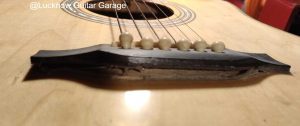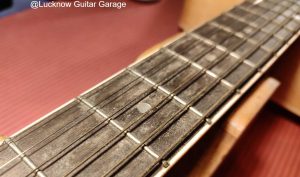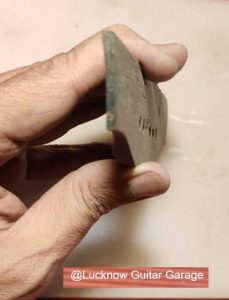I have said this before but I will say it again: wood has a memory. Once it attains a shape, it likes to stay in that shape. You can give it all the heat and moisture that you want and try to bend it the other way but soon after the external factors (heat, moisture, clamping pressure) are removed, it returns to its original position.
This could be a warped table top, cupboard door, arm rest on your favourite chair and just about anything made of wood.
In the case of acoustic guitars, try and think of a twisted neck or a tensioned-out-of-whack bridgeplate: they too shall return to the ‘normal’ they know as soon as the external factors are removed.
If it’s the bridgeplate and you throw on strings on your guitar, it is a surety that if the warp in the bridgeplate would have returned in 90 days, under string tension, it will return in 45.
And here I am, doling out wisdom after I suffered at the hands of a particularly truant bridgeplate!
The antecedents of this naughty bridgeplate are recorded here
and here
Snow White returned and I noticed that someone else had tried something with it for the bridge was lifting – gaping actually – and in the yawning gap I could clearly see something like epoxy.

The owner explained that the bridge had begun to lift again and so another repair person was consulted. So, after this repair person’s luck failed him, Snow White seemed to have been stood in a corner and forgotten about! And so it accumulated dust and dust worms one too many.




The accumulation on the saddle is rather telling, wouldn’t you say so? Whateva!
But as I looked at the guitar, it was apparent that string tension had more than played its part in all the days that the instrument had been left standing. The bridge was completely contorted.
As I tried to pull out the bridgepins and remove the strings, this happened

As I took the bridge off, this is what I saw – my old friend, Epoxy!

Meanwhile, the bridge itself was on an almighty curl.



Do you see it too?
Since it was in my hands, I started working first on the bridge itself. I first cleaned the under surface and then went about trying to straighten the bridge. It wasn’t heat, moisture and clamping but just plain sanding.
Mark the bridge, lay it flat on a sandpaper and keep sanding till the marks disappear. Have a second go at it and then a third till all the marks go in two or three strokes.





The last few photographs show how flat I was able to get it. Yes, if you see clearly, you will notice that one of the wings is thinner than the other. But that had to happen if one wanted to straighten the bridge out.
But this was just half the job. The other half entailed that I flatten the belly in the top too.
However, as I looked, it seemed to me as if the there was a crack running right through the bridgepin holes in the top. A closer inspection proved I was correct.

Before anything else, this needed to be rectified; and rectified it was.

To remove the belly from the top and taking into consideration the past of the instrument, this time, I chose a thicker, longer board, wet both the bridgeplate as well as the top and clamped up everything tight before you could breathe!
After 36 hours, there was some change but not as much as I would have liked to see. So, I had another go at it and changed the position of the clamps.



After 48 hours, the results were more encouraging.

With a relatively flat belly, the stage was set for the mating of the two surfaces: the bridge and the top.
Lots of glue, lots of planning and even more clamps later



After 48 hours, it looked like time to release the stranglehold on the instrument. The clamps were taken off and the instrument set aside to let it breathe.
As it breathed, it was just the right time to buff out the body.

And a little love potion on the fretboard and some TLC for the fretwires and Snow White was resplendent again and ready for strings.

After stringing it up, I left it for another 2 -3 days to see how the instrument was coping with the stress of the strings.
It was doing fine for that period but soon the action started rising and as I looked at the bridge…

Ah, well…! You can’t win always!
